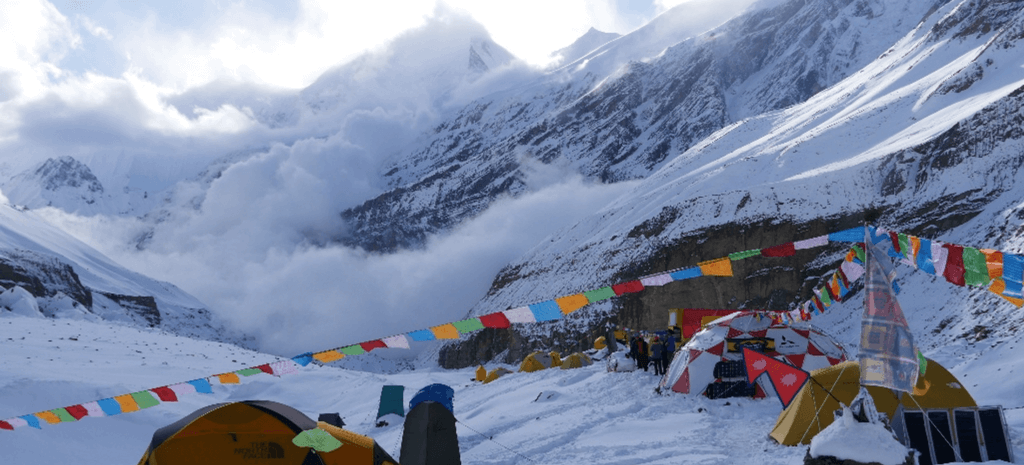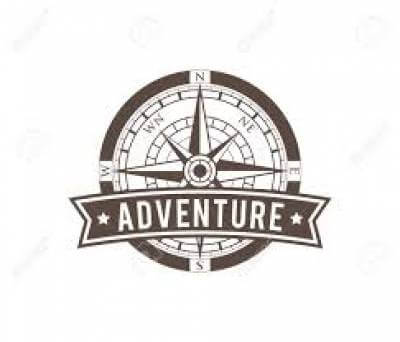Dhaulagiri Circuit Trek
If you are looking for a more physically challenging adventure into the wild - then this may be just what you are looking for.
The Dhaulagiri Circuit Trek is rated as “high-advanced” ascending to 5100 meters and heads to some far-off and isolated regions crossing high altitude passes and follows a trail around the Dhaulagiri Massif. Mt. Dhaulagiri (8167m) is known as "The white mountain" and is the world's seventh-highest peak.
We take trails through Hidden Valley set among white snow-covered mountains and sparse desolate terrain. The Hidden Valley is bordered on one side by the Boudha Himal and Himal Chuli in the west, Ganesh Himal in the south and Sringi Himal in the North. This area has remained unchanged for centuries due to it being isolated from the southern lowlands by yawning gorges and rivers and from Tibet in the north by snow-covered passes.
The Mt. Dhaulagiri (8167m) trek is not for beginners for you will be required to head through the French Pass at 5360 meters that will be a test of your endurance, but with well planned prior acclimatization it will not be so difficult.
The name Dhaulagiri derives from the Sanskrit word (dhawala) that means dazzling, white, beautiful and (giri) meaning mountain. Dhaulagiri 1 is also the highest peak in the Gandaki river basin area.
Annapurna I (8091m) lies only 34 km to the east of Dhaulagiri. The Kali Gandaki River flows between the two in the Kaligandaki Gorge and is said to be the world's deepest gorge. The town of Pokhara is south of the Annapurnas and is an important starting point for treks in this region.
The trek starts as you head up the slopes of terraced farmlands and through forests in a region populated by the Magar people, a caste with more than 20 sub-castes. The trail will take you across moraines and close to Dhaulagiri, across French Pass (5360m) and to Hidden Valley. At this stage of the trek we may choose to climb Dhampus Peak (6060m). The trail continues over Dhampus Pass (5240m) and finally heads down to Jomsom where the trek ends.
The Dhaulagiri Circuit Trek is more physically demanding than the Annapurna Circuit Trek or the Manaslu Circuit Trek and requires that you are physical fit and able to endure several days trekking across barren gravel and stone moraines at the base of mountain glaciers.
Sherpa Expedition Teams (Est.1977) have had more than 40 years taking trekkers to the Himalayan Mountains and will take care of all the preparation and paperwork, such as permits, as well as meals and accommodation on the trek. We have an excellent reputation for safety and taking care of our clients.
ITINERARY
Day 1 : Arrival in Kathmandu and transfer to hotel.
On your arrival at Kathmandu Tribhuvan International Airport, you will be met by Sherpa Expedition and trekking staff and transferred to your respective hotels followed by a briefing regarding Dhaulagiri trek.
Day 2 : Drive from Kathmandu to Pokhara - Darbang (1,100m) Duration: 10-12 hours.
We take private jeep drive for 10 hours down into the Kali Gandaki Valley and up the tributary of the Myagdi Khola valley until we reach Darbang where we will stay the night.
Day 3 : Trek from Darbang to Dharapani (1400m) Duration: 5-6 hours.
The trek continues as you make your way to Dharapani. The trail goes through terraced fields, small villages, and lush forests. You will spend the night in Dharapani.
Day 4 : Trek from Dharapani to JugePani (1300m) Duration: 5-6 hours
The trek continues as you make your way to Jugepani. The trail goes through terraced fields, small villages, and lush forests. You will spend the night in Jugapani.
Day 5 : Trek from Jugepani to Boghara (2,414m) Duration: 5-6 hours.
We start our day by ascending to the ridge and then descending to Juge Pani where we stop for a lunch break. After lunch we ascend along a steep trail and then find ourselves high above the valley. The trail follows along a cliff edge and after about an hour we reach Boghara Village where we camp for the night.
Day 6 : Trek from Boghara to Dobang (2,520m) Duration: 6-7 hours.
The trail today begins as we head through cultivated fields while ascending to the ridge. The trail becomes a little less tiring and then we reach Lipshe Village where we stop for lunch. We then trek through dense forest for about two to three hours until we reach Dobang Village where we camp for the night.
Day 7 : Trek from Dobang to Sallaghari (2,500m) Duration: 5-6 hours.
Today is another day of gaining altitude as we continue through forests and grazing lands around Dobang. After a lunch break we continue on to Sallaghari where we make camp for the night.
Day 8 : Trek From Sallaghari to Italian Base Camp (3,660m) Duration: 4-5 hours.
Today we need to remain focused as the trail is less defined and you will need to watch your balance as some of the trails can be dangerous. We follow the wild Myagdi Khola (river), stepping over logs and using your limbs to scramble up the more uneven areas of the track. We then ascend through bamboo and other untouched forests. Along the trail you may see Langur monkeys scrambling about the treetops. After another three to four hours on the trail we reach Dobhan and then Sallaghari where we will stop for lunch. After lunch we continue to climb up through prickly aeglea brush (broom bush). Two to three hours later we finally reach Italy Base Camp previously used by Italian explorers prior to the ascent of Dhaulagiri. Tonight we camp at Italy Base Camp.
Day 9 : Rest Day at Italians base Camp
Acclimatization is important for your safety before heading to higher elevations. Medical professionals recommend that you stay active during the day, We can do small hiking.
Day 10 : Trek from Itilian Base camp to Japanese Base Camp (4,300m) Duration: 4-5 hours.
Today is a short trek of four to five hours before we reach Japnese Base Camp. Along the trail, after leaving Italy Base Camp you will pass several memorials of climbers who perished while attempting to climb Dhaulagiri, which includes three Chinese climbers who died in 2010. Previous trekkers have left a fixed rope making the descent less risky. We then cross the moraine to the Japnese Base Camp where there is a single hut. We set up camp here for the night.
Day 11 : Trek from Japanese Camp to Dhaulagiri Base Camp (4,748m) Duration: 7-8 hours.
Today’s trek is about seven to eight hours. We follow a trail across the Dhaulagiri moraine below the glacier until we reach Dhaulagiri Base Camp which will hopefully be before lunch if we leave early enough in the morning. Our camp here tonight is surrounded by Himalayan peaks – a breathtaking experience.
Day 12 : Trek from Dhaulagiri Base Camp to Hidden Valley (5,120m) via French Pass (5,360m) Duration: 6-7 hours.
For those who wish to climb Dhampus Peak (6,060m) there will be an early start at around 3 am. The climb to Dhampus Peak and return to Yak Kharka will take about 10 hours. Tonight we set up camp at Yak Kharka.
Day 13 : Trek from Hidden Valley to Yak Kharka (3,837m) Duration: 6-7 hours.
The trek today has some memorable views of Dhaulagiri Peak in the southwest, Annapurna and Nilgiri in the east, and far off Mustang in the north as well as the deepest gorge on earth - the Kali Gandaki Valley. The trail is fairly easy going until we get nearer to Yak Kharka when it descends rapidly to Marpha Village where we can stop for lunch. After lunch we continue to Jomsom where we stay the night in a lodge.
Day 14 : Trek from Yak Kharka to Marpha (2,670m) Duration: 4-5 hours.
The trek today has some memorable views of Dhaulagiri Peak in the southwest, Annapurna and Nilgiri in the east, and far off Mustang in the north as well as the deepest gorge on earth - the Kali Gandaki Valley. The trail is fairly easy going until we get nearer to Yak Kharka when it descends rapidly to Marpha Village where we can stop for overnight. we will stay at teahouse.
Day 15 : Drive From Marpha to Pokhara (8,50m) Duration: 6-7 hours.
On Day 15, after a fulfilling trekking experience in the Dhaulagiri Circuit, you will embark on a scenic drive from Marpha to Pokhara.
Leaving the charming village of Marpha behind, you will be surrounded by stunning views of the Annapurna and Dhaulagiri mountain ranges as you descend along the Kali Gandaki River Valley. The drive takes you through picturesque landscapes, passing through small traditional villages, terraced fields, and lush green forests.
Day 16 : Drive from Pokhara to Kathmandu; Duration: 6-7 hours.
Today we head back to Kathmandu, either by bus or private vehicle depending on the size of the group. Upon arrival at Kathmandu, you will be taken to your respective hotels situated close to the main tourist hub – Thamel.
Day 17 : Transfer to Tribhuvan International Airport.
Your adventure comes to an end today – but your memories will last a lifetime! Our company representative will take you to the airport approximately 3 hours before your scheduled flight. On your way home you'll have plenty of time to plan your next adventure and explore the most magnificent mountains of Nepal.
SERVICES
Costs Included In Your Package
- Airport picks up and transports by private Car/Jeep.
- Two Night's hotel accommodation In Kathmandu with breakfast (3 star Hotel)
- One Night hotel accommodation In Pokhara with breakfast (3 star Hotel)
- Transportation from Marpha to Pokhara by Public Bus.
- Pokhara to Kathmandu transportation by Tourist Bus.
- All standard meals - 3 meals a day (lunch, dinners & breakfast) during the trek.
- Twin sharing tented accommodation during the trek (after Itilian Base camp to Yak Kharka)
- Trekking equipment (two men tent, dining tent, kitchen tent, table with chairs, kitchen utensils, and other necessary equipment during the trek)
- Best possible teahouses, lodge accommodation (generally twin share rooms)- during the trek
- Government licensed holder English speaking trek leader (10 or more trekkers an assistant guide) and porter to help carry your luggage.
- Strong, helpful Sherpa porters with proper safety equipment and walking equipment, his salary, food, accommodation, and insurance (one porter for two people).
- Guides and porters provided by Sherpa Trekking & Expeditions, including their meals, insurance, salary, lodging, transportation, and other necessary equipment
- All the required permits and paper works( Annapurna Conservation area Permit, TIMS etc)
- All government, local taxes, and official expenses
- Assistance in arranging rescue operations in case of complicated health conditions such as altitude sickness (funded by travel insurance)
- Souvenir - Sherpa Trekking & Expeditions t-shirt
- Use of sleeping bag, down jacket, duffel bag, and walking poles (if you don’t have your own, to be returned after the trip is completed).
- Sherpa Expedition and Trekking’s certificate of appreciation & completion after the successful trek
- Oxygen meter to check your pulse and oxygen saturation and heart rate twice daily (Very useful to check Altitude Mountain Sickness(AMS) symptoms) which will ensure your health during the trek.
Costs Exclude
- International airfares
- Nepal entry visa fee (easy to obtain the visa on arrival at Tribhuvan International Airport – Kathmandu). $30 USD for 15-day, $50 USD for 30 Days, and $125 USD for 90 Days visa.
- Extra night’s accommodation in Kathmandu due to early arrival or late departure or early return from the trek.
- All the alcoholic and nonalcoholic, soup, tea, coffee, hot chocolate, cocoa, mineral water, extra food, cold and hot drinks on trek ( i.e. those you choose to purchase along the way and during evenings in the tea houses)
- All desserts & sweet things like chocolate, cake, pie, pudding.
- Hot shower and battery charging at the tea houses.
- Lunch and dinner in Kathmandu & Pokhara
- Personal clothing and gear
- Travel insurance which has to cover emergency high-altitude rescue and evacuation (compulsory)
- Tips for guide and porters (recommended in our culture – and well deserved too!)
- Additional costs or delays caused by events beyond our control, for example, landslides, severe weather conditions, itinerary modification due to safety concerns, illness, change of government policies & strikes.
- All the costs and expenses which are not listed in "costs include" will be counted as exclusions.
EQUIPMENTS
The following information will give you some idea about what you need to bring for the trek. It is important you do not forget the essential items, as this will determine your comfort and safety on the trek. Equally important is that you do not burden yourself with unnecessary equipment on the trek.
- Sleeping Bag (Sherpa Teams will provide but need to return after completing the trip)
- Duffel Bag (Sherpa Teams will provide but need to return after completing the trip)
- Fleece jacket or pullover
- Waterproof windbreaker or windcheater
- Thermal underclothes
- Rain poncho
- Down jacket (Sherpa Teams will provide but need to return after completing the trip)
- Fleece or wool trousers
- Sun hat or scarf
- Trekking pants (two pairs)
- Mittens or woolen gloves
- Hiking socks (several pairs)
- Moisture-wicking shirts, including t-shirts
- Trekking shoes or boots with spare laces
- Flip-flops or sandals for relaxing in the evenings
- Underwear (several pairs)
- Swimsuit or swimming costume
- Sunglasses
- Headlamp or flashlight/torch
- Sleeping bag (Sherpa Teams can provide this for you)
- Trekking poles (if desired)
- Hiking backpack with a capacity of at least 40 liters
- Small lock for your backpack
- Reusable water bottles (at least two liters)
- Water purification tablets or filtration device
- Wash towel
- Basic first aid kit
Toiletries (tissues, toilet paper, moisturizer, lip balm, sunscreen, sanitary pads, hand sanitizer, nail clippers, a small mirror, toothbrush, toothpaste, glasses, contacts, etc.)
GOOD TO KNOW
Accommodation
You will be accommodated in 3-star hotels in Kathmandu. During the trek, we will be staying at lodges/ teahouses. You may not find comfortable and better quality teahouses -During the trek, We sleep in the very simple tea house/tent and our guides will pick the best Camping site with a nice view of the Himalaya.
Meals during the trek
In Kathmandu your hotel includes breakfast, whereas all meals (breakfast, lunch, and dinner) will be provided during the trek. A staple food of these mountain regions are potatoes, oats, buckwheat, Sherpa stew and Tibetan bread. Sherpas started farming potatoes when the first seeds were introduced to the region in the early 90s. There is a limited choice of food at higher elevations and except many potato dishes. Potatoes are high in carbohydrates – an excellent source of energy needed at high altitudes.
Transportation
We use a private car for sightseeing and for the airport to hotel pick and drop off. We do not have to use public transportation or local buses during the trek. Our only flights are from Kathmandu, Jomson and Pokhara.
Physical fitness
Dhaulagiri is a challenging trek where you often have to walk 6-7 hours a day. You need past experience of hiking or trekking but if you have done any kind of trekking activities then it is always a plus!. We have met people from all walks of life, shapes and sizes who have completed the trek. The only difficult part is when altitude sickness strikes and the effect that it can have on your body. Before leaving for Nepal it is good if you can prepare yourself physically by increasing your stamina and oxygen intake.
Remember – The better prepared – the more enjoyable your trek!
MAP
PHOTOS/Videos
Departures
Select a departure month
Fill out the form below and a Travel Expert will reach out to create your perfect tour.
FAQS
What is the Dhaulagiri Circuit Trek?
The Dhaulagiri Circuit Trek is a challenging and remote trekking route in the Dhaulagiri region of Nepal. It is known for its stunning views of the Dhaulagiri mountain range, including the seventh highest mountain in the world, Mount Dhaulagiri (8,167 meters). The trek takes you through diverse landscapes, including lush forests, terraced fields, and high alpine passes.
How long does the Dhaulagiri Circuit Trek take?
The Dhaulagiri Circuit Trek typically takes around 15-20 days to complete. This includes the trekking days and acclimatization/rest days. However, the duration can vary depending on your fitness level and the itinerary you choose.
Is the Dhaulagiri Circuit Trek difficult?
Yes, the Dhaulagiri Circuit Trek is considered to be a challenging trek. It involves long and steep ascents and descents, crossing high passes, and trekking at high altitudes. Previous trekking experience and a good level of fitness are recommended.
What is the best time to do the Dhaulagiri Circuit Trek?
The best time to do the Dhaulagiri Circuit Trek is during the spring (March to May) and autumn (September to November) seasons. These months offer stable weather conditions, clear skies, and moderate temperatures, making it ideal for trekking. However, it is important to check the weather forecast and be prepared for changing weather conditions in the mountains.
Do I need a permit for the Dhaulagiri Circuit Trek?
Yes, you need a special trekking permit called the "Restricted Area Permit" to do the Dhaulagiri Circuit Trek. Additionally, you will also need the Annapurna Conservation Area Permit (ACAP) and the TIMS (Trekkers' Information Management System) card. These permits can be obtained through a registered trekking agency in Nepal.
Is it necessary to hire a guide or porter for the Dhaulagiri Circuit Trek?
While it is not mandatory to hire a guide or porter for the Dhaulagiri Circuit Trek, it is highly recommended. A guide can provide valuable information about the route, ensure your safety, and assist with navigation. A porter can help carry your heavy backpack, allowing you to trek more comfortably.
Are there teahouses or lodges along the Dhaulagiri Circuit Trek?
Yes, there are teahouses and lodges available along the Dhaulagiri Circuit Trek route. However, the availability of these facilities may be limited in some remote areas. It is advisable to carry some cash for accommodation and meals, as credit card facilities may not be available.
What equipment do I need for the Dhaulagiri Circuit Trek?
You will need to pack essential trekking gear such as a good quality backpack, trekking boots, warm clothing layers, a sleeping bag, a trekking pole, a headlamp, and a first aid kit. It is also recommended to bring a good quality map or hire a guide for navigation.
Is altitude sickness a concern on the Dhaulagiri Circuit Trek?
Yes, altitude sickness can be a concern on the Dhaulagiri Circuit Trek, as you will be trekking at high altitudes. It is important to acclimatize properly, stay hydrated, and ascend gradually to minimize the risk of altitude sickness. It is advisable to consult with a doctor before the trek and be aware of the symptoms of altitude sickness.
Can I do the Dhaulagiri Circuit Trek solo?
Yes, it is possible to do the Dhaulagiri Circuit Trek solo. However, it is recommended to have previous trekking experience, good navigation skills, and knowledge of high-altitude trekking. Hiring a guide or joining a trekking group can enhance your safety and overall trekking experience.
Latest Traveller’s Reviews
Travel experiences of our clients who recently returned from their trips.
100%
Based On 20 Reviews
Mary Naomi
Australia
September 13, 2024
Well-Organized Trek
Sherpa Expedition’s team made our Dhaulagiri Circuit Trek well-organized and enjoyable with their expert care. The guides were highly knowledgeable, expertly navigating the trek and providing insightful information about the region. Their commitment to our safety and comfort was evident. The support staff handled all logistical details with efficiency and attention to detail, ensuring a smooth trek. Their dedication to delivering a high-quality experience made the adventure truly memorable. Sherpa Expedition is a great choice for an outstanding trekking experience.
Zyta Michalak
United States
August 25, 2024
Exceptional Trekking Experience
Our Dhaulagiri Circuit Trek with Sherpa Expedition was an exceptional experience. The guides were professional and knowledgeable, offering valuable insights into the trek and ensuring our safety in challenging conditions. Their friendly approach made the trek enjoyable. The support staff was equally impressive, efficiently managing all logistical aspects and ensuring our comfort. Their commitment to providing a seamless and memorable trek was evident throughout. For a high-quality trekking adventure, Sherpa Expedition is an excellent choice.
Ovalle David
Denmark
August 2, 2024
Excellent Guides and Seamless Support
Sherpa Expedition provided excellent guides and seamless support on our Dhaulagiri Circuit Trek. The guides were highly skilled and offered informative commentary on the trek’s challenging terrain and stunning scenery. Their focus on safety and well-being was reassuring. The support staff’s efficiency in handling logistics, from meals to accommodations, was impressive. Their dedication to ensuring a comfortable and enjoyable trek greatly enhanced our experience. I highly recommend Sherpa Expedition for their superior trekking service.
People Considering This Package Right Now Check availability
























